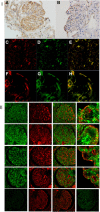Membranous Nephropathy in Syphilis is Associated with Neuron-Derived Neurotrophic Factor
- PMID: 36857498
- PMCID: PMC10103242
- DOI: 10.1681/ASN.0000000000000061
Membranous Nephropathy in Syphilis is Associated with Neuron-Derived Neurotrophic Factor
Abstract
Significance statement: Syphilis is a common worldwide sexually transmitted infection. Proteinuria may occur in patients with syphilis. Membranous nephropathy (MN) is the most common cause of proteinuria in syphilis. The target antigen of MN in syphilis is unknown. This study shows that MN in syphilis is associated with a novel target antigen called neuron-derived neurotrophic factor (NDNF). NDNF-associated MN has distinctive clinical and pathologic manifestations and NDNF appears to be the target antigen in syphilis-associated MN.
Background: Syphilis is a common sexually transmitted infection. Membranous nephropathy (MN) is a common cause of proteinuria in syphilis. The target antigen is not known in most cases of syphilis-associated MN.
Methods: We performed laser microdissection of glomeruli and mass spectrometry (MS/MS) in 250 cases (discovery cohort) of phospholipase A2 receptor-negative MN to identify novel target antigens. This was followed by immunohistochemistry/confocal microscopy to localize the target antigen along the glomerular basement membrane (GBM). Western blot analyses using IgG eluted from frozen biopsy tissue were performed to detect binding to target antigen.
Results: MS/MS studies of the discovery cohort revealed high total spectral counts of a novel protein, neuron-derived neurotrophic factor (NDNF), in three patients: one each with syphilis and hepatitis B, HIV (syphilis status not known), and lung tumor. Next, MS/MS studies of five cases of syphilis-MN (validation cohort) confirmed high total spectral counts of NDNF (average 45±20.4) in all (100%) cases. MS/MS of 14 cases of hepatitis B were negative for NDNF. All eight cases of NDNF-associated MN were negative for known MN antigens. Electron microscopy showed stage I MN in all cases, with superficial and hump-like deposits without GBM reaction. IgG1 was the dominant IgG subtype on MS/MS and immunofluorescence microscopy. Immunohistochemistry/confocal microscopy showed granular staining and colocalization of NDNF and IgG along GBM. Western blot analyses using eluate IgG of NDNF-MN showed binding to both nonreduced and reduced NDNF, while IgG eluate from phospholipase A2 receptor-MN showed no binding.
Conclusion: NDNF is a novel antigenic target in syphilis-associated MN.
Copyright © 2023 by the American Society of Nephrology.
Figures






References
-
- Centers for Disease Control and Prevention. Preliminary 2021 STD Surveillance Data. 2022. https://www.cdc.gov/std/statistics/2021/default.htm.
Publication types
MeSH terms
Substances
Grants and funding
LinkOut - more resources
Full Text Sources
Medical

